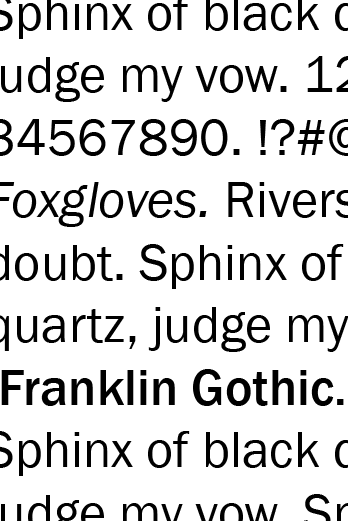I use this space to gather notes and samples of typefaces. My purpose here is not to be exhaustive, but to learn and be useful in the process.
Serif Sans-serif Italic Script
Say
Hello
I use this space to gather notes and samples of typefaces. My purpose here is not to be exhaustive, but to learn and be useful in the process.

Developed by Morris Fuller Benton in 1903, Franklin Gothic was named after the American statesman Benjamin Franklin.
Developed by Morris Fuller Benton in 1903, Franklin Gothic was named after the American statesman Benjamin Franklin.*
One of the most interesting things about Franklin Gothic is that, as Lawson points out, it has nothing to do with Benjamin Franklin and is not really a “gothic” font. For most of the history of typography gothic type meant Blackletter, like the original typeface used by Gutenberg in his famous printing press. This helpful passage from Frank Chouteau Brown’s Letters and Lettering (1921) explains the origin and the original understanding of the term “Gothic” as applied to type:
The name “Gothic” applies rather to the spirit than to the exact letter forms of the style. The same spirit of freedom and restlessness characterizes the architecture of the period wherein this style of letter was developed; and Gothic letters are in many ways akin to the fundamental forms of Gothic architecture. Their effect is often tiring and confusing to the eye because of the constant recurrence of very similar forms with different letter meanings; yet this very similarity is the main cause of the pleasing aspect of a page of Gothic lettering.
Unlike the Roman letters, which attained a complete and final development, Gothic letters never reached authoritative and definitive forms, any more than did Gothic architecture. Every individual Gothic letter has several quasi-authoritative shapes, and all of these variants may be accepted, as long as they display an intelligent conception of the spirit of the style as a whole. Because of this lack of finality, however, it is impossible to analyze each of the letter forms as we were able to do with the Roman alphabet in Chapter I; yet this very variability and variety constitute at once the peculiar beauty of Gothic and the great difficulty of so drawing it as to preserve its distinctive character.
Any letter of Gothic form is usually called either “Gothic” or “Blackletter” indiscriminately, but this use is inexact and confusing. The term “Blackletter” should, strictly, be applied only to letters in which the amount of black in the line overbalances the white; and the proper application of the title should be determined rather by this balance or weight of the letter than by its form.
True “gothic” type would look more like this:
Bringhurst writes that Franklin Gothic and Helvetica were both directly influenced by Akzidenz Grotesk.
*Among his many talents, Franklin was known for his printing and was an admirer of the high contrast letterforms created by John Baskerville.
Notes and sources:
Alexander Lawson, Anatomy of a Typeface
Robert Bringhurst, The Elements of Typographic Style
Ellen Lupton, Thinking With Type
Phillip B. Meggs, A History of Graphic Design
Alan Bartram, Five Hundred Years of Book Design
Wikipedia, among others. Some images from Wikipedia are used under the Creative Commons license, and have been resized.